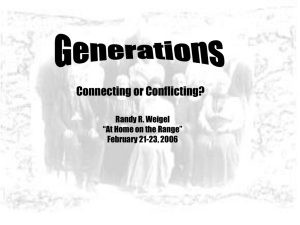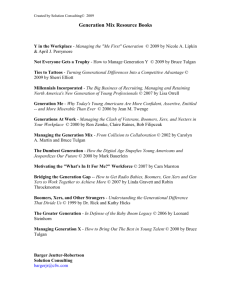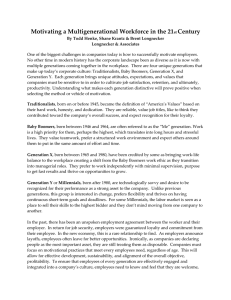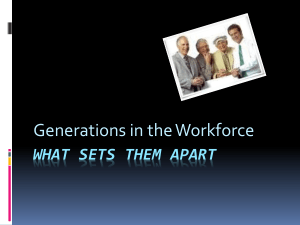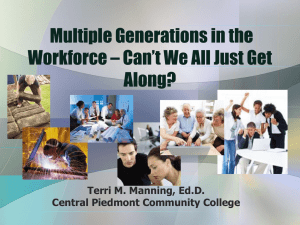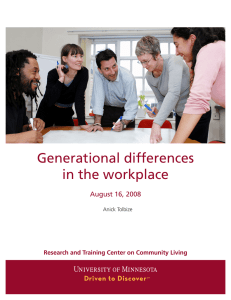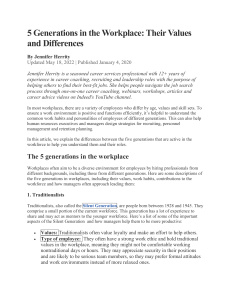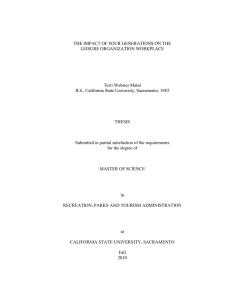Minding the generation gap Four Generations Bring
advertisement
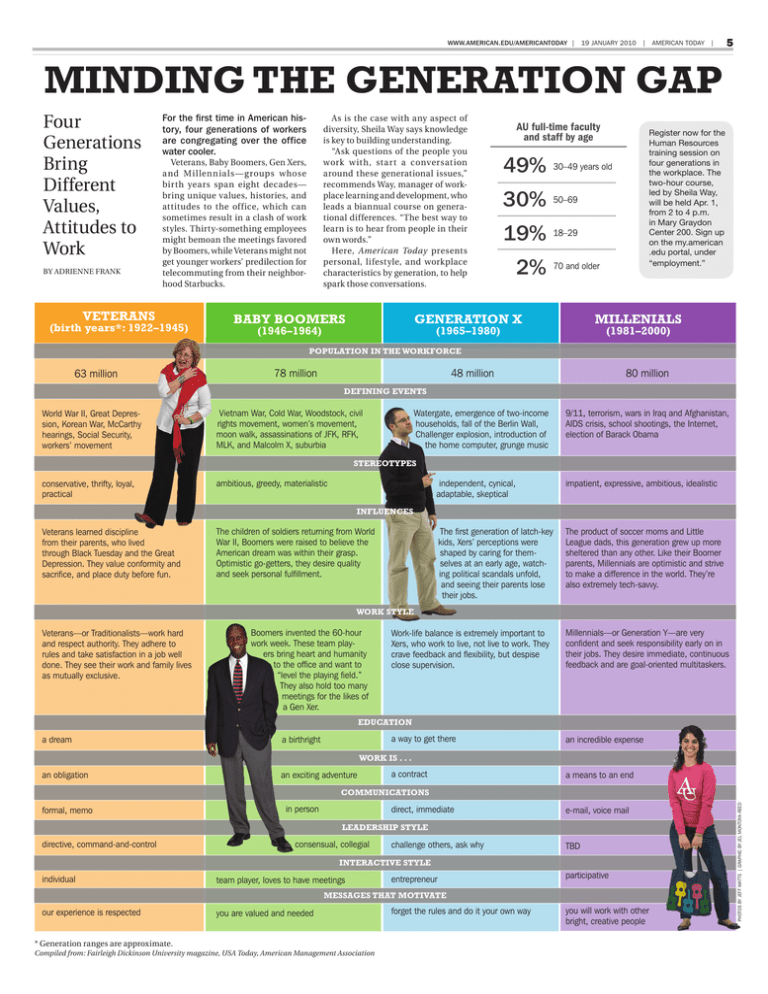
www.american.edu/americantoday | 19 january 2010 | american today | 5 Minding the Generation Gap Four Generations Bring Different Values, Attitudes to Work BY ADRIENNE FRANK For the first time in American history, four generations of workers are congregating over the office water cooler. As is the case with any aspect of diversity, Sheila Way says knowledge is key to building understanding. “Ask questions of the people you work w it h, sta rt a conversation around these generational issues,” recommends Way, manager of workplace learning and development, who leads a biannual course on generational differences. “The best way to learn is to hear from people in their own words.” Here, American Today presents personal, lifestyle, and workplace characteristics by generation, to help spark those conversations. Veterans, Baby Boomers, Gen Xers, a nd Mi l lennia ls—g roups whose birth years span eight decades— bring unique values, histories, and attitudes to the office, which can sometimes result in a clash of work styles. Thirty-something employees might bemoan the meetings favored by Boomers, while Veterans might not get younger workers’ predilection for telecommuting from their neighborhood Starbucks. VETERANS (birth years*: 1922–1945) BABY BOOMERS AU full-time faculty and staff by age 49% 30–49 years old 30% 50–69 19% 18–29 2% 70 and older GENERATION X (1946–1964) Register now for the Human Resources training session on four generations in the workplace. The two-hour course, led by Sheila Way, will be held Apr. 1, from 2 to 4 p.m. in Mary Graydon Center 200. Sign up on the my.american .edu portal, under “employment.” MILLENIALS (1965–1980) (1981–2000) POPULATION IN THE WORKFORCE 63 million 78 million 48 million 80 million DEFINING EVENTS World War II, Great Depression, Korean War, McCarthy hearings, Social Security, workers’ movement Vietnam War, Cold War, Woodstock, civil rights movement, women’s movement, moon walk, assassinations of JFK, RFK, MLK, and Malcolm X, suburbia Watergate, emergence of two-income households, fall of the Berlin Wall, Challenger explosion, introduction of the home computer, grunge music 9/11, terrorism, wars in Iraq and Afghanistan, AIDS crisis, school shootings, the Internet, election of Barack Obama STEREOTYPES conservative, thrifty, loyal, practical ambitious, greedy, materialistic independent, cynical, adaptable, skeptical impatient, expressive, ambitious, idealistic The first generation of latch-key kids, Xers’ perceptions were shaped by caring for themselves at an early age, watching political scandals unfold, and seeing their parents lose their jobs. The product of soccer moms and Little League dads, this generation grew up more sheltered than any other. Like their Boomer parents, Millennials are optimistic and strive to make a difference in the world. They’re also extremely tech-savvy. INFLUENCES Veterans learned discipline from their parents, who lived through Black Tuesday and the Great Depression. They value conformity and sacrifice, and place duty before fun. The children of soldiers returning from World War II, Boomers were raised to believe the American dream was within their grasp. Optimistic go-getters, they desire quality and seek personal fulfillment. WORK STYLE Veterans—or Traditionalists—work hard and respect authority. They adhere to rules and take satisfaction in a job well done. They see their work and family lives as mutually exclusive. Boomers invented the 60-hour work week. These team players bring heart and humanity to the office and want to “level the playing field.” They also hold too many meetings for the likes of a Gen Xer. Work-life balance is extremely important to Xers, who work to live, not live to work. They crave feedback and flexibility, but despise close supervision. Millennials—or Generation Y—are very confident and seek responsibility early on in their jobs. They desire immediate, continuous feedback and are goal-oriented multitaskers. EDUCATION a dream a way to get there a birthright an incredible expense WORK IS . . . an obligation an exciting adventure a contract a means to an end formal, memo in person direct, immediate e-mail, voice mail LEADERSHIP STYLE directive, command-and-control consensual, collegial challenge others, ask why TBD INTERACTIVE STYLE individual team player, loves to have meetings entrepreneur participative MESSAGES THAT MOTIVATE our experience is respected you are valued and needed * Generation ranges are approximate. Compiled from: Fairleigh Dickinson University magazine, USA Today, American Management Association forget the rules and do it your own way you will work with other bright, creative people photos by jeff watts | graphic by jel montoya-reed COMMUNICATIONS
